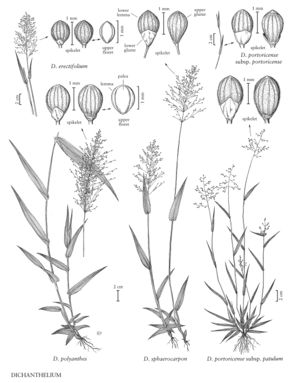Difference between revisions of "Dichanthelium sphaerocarpon"
FNA>Volume Importer |
imported>Volume Importer |
||
| (4 intermediate revisions by 2 users not shown) | |||
| Line 7: | Line 7: | ||
|synonyms={{Treatment/ID/Synonym | |synonyms={{Treatment/ID/Synonym | ||
|name=Panicum sphaerocarpon var. inflatum | |name=Panicum sphaerocarpon var. inflatum | ||
| − | |authority= | + | |authority= |
| + | |rank=variety | ||
}} {{Treatment/ID/Synonym | }} {{Treatment/ID/Synonym | ||
|name=Panicum sphaerocarpon | |name=Panicum sphaerocarpon | ||
| − | |authority= | + | |authority= |
| + | |rank=species | ||
}} | }} | ||
|hierarchy=Poaceae;Poaceae subfam. Panicoideae;Poaceae tribe Paniceae;Dichanthelium;Dichanthelium sect. Sphaerocarpa;Dichanthelium sphaerocarpon | |hierarchy=Poaceae;Poaceae subfam. Panicoideae;Poaceae tribe Paniceae;Dichanthelium;Dichanthelium sect. Sphaerocarpa;Dichanthelium sphaerocarpon | ||
| Line 22: | Line 24: | ||
-->{{Treatment/Body | -->{{Treatment/Body | ||
| − | |distribution=Del.;W.Va.;Fla.;N.H.;N.J.;Tex.;La.;Tenn.;N.C.;S.C.;Pa.;N.Y.;Va.;Ont.;Conn.;Mass.;R.I.;Vt.;Ala.;Ark.;Ill.;Ga.;Ind.;Maine;Md.;Kans.;Okla.;Ohio;Mo.;Mich.;Miss.;Ky.;D.C | + | |distribution=Del.;W.Va.;Fla.;N.H.;N.J.;Tex.;La.;Tenn.;N.C.;S.C.;Pa.;N.Y.;Va.;Ont.;Conn.;Mass.;R.I.;Vt.;Ala.;Ark.;Ill.;Ga.;Ind.;Maine;Md.;Kans.;Okla.;Ohio;Mo.;Mich.;Miss.;Ky.;D.C. |
| − | |discussion=<p>Dichanthelium sphaerocarpon grows in dry, open woods and roadsides. Its range extends from eastern North America to Ecuador and Venezuela. It occasionally hybridizes with other species, including D. polyanthes, D. acuminatum, and D. laxiflorum.</p> | + | |discussion=<p><i>Dichanthelium sphaerocarpon</i> grows in dry, open woods and roadsides. Its range extends from eastern North America to Ecuador and Venezuela. It occasionally hybridizes with other species, including <i>D. polyanthes</i>, <i>D. acuminatum</i>, and <i>D. laxiflorum</i>.</p> |
|tables= | |tables= | ||
|references= | |references= | ||
| Line 32: | Line 34: | ||
-->{{#Taxon: | -->{{#Taxon: | ||
name=Dichanthelium sphaerocarpon | name=Dichanthelium sphaerocarpon | ||
| − | |||
|authority=(Elliott) Gould | |authority=(Elliott) Gould | ||
|rank=species | |rank=species | ||
| Line 39: | Line 40: | ||
|basionyms= | |basionyms= | ||
|family=Poaceae | |family=Poaceae | ||
| − | |illustrator=Linda A. Vorobik | + | |illustrator=Linda A. Vorobik;Hana Pazdírková |
| − | |distribution=Del.;W.Va.;Fla.;N.H.;N.J.;Tex.;La.;Tenn.;N.C.;S.C.;Pa.;N.Y.;Va.;Ont.;Conn.;Mass.;R.I.;Vt.;Ala.;Ark.;Ill.;Ga.;Ind.;Maine;Md.;Kans.;Okla.;Ohio;Mo.;Mich.;Miss.;Ky.;D.C | + | |illustration copyright=Utah State University |
| + | |distribution=Del.;W.Va.;Fla.;N.H.;N.J.;Tex.;La.;Tenn.;N.C.;S.C.;Pa.;N.Y.;Va.;Ont.;Conn.;Mass.;R.I.;Vt.;Ala.;Ark.;Ill.;Ga.;Ind.;Maine;Md.;Kans.;Okla.;Ohio;Mo.;Mich.;Miss.;Ky.;D.C. | ||
|reference=None | |reference=None | ||
|publication title= | |publication title= | ||
|publication year= | |publication year= | ||
|special status= | |special status= | ||
| − | |source xml=https:// | + | |source xml=https://bitbucket.org/aafc-mbb/fna-data-curation/src/200273ad09963decb8fc72550212de541d86569d/coarse_grained_fna_xml/V25/V25_1197.xml |
|subfamily=Poaceae subfam. Panicoideae | |subfamily=Poaceae subfam. Panicoideae | ||
|tribe=Poaceae tribe Paniceae | |tribe=Poaceae tribe Paniceae | ||
Latest revision as of 17:56, 11 May 2021
Plants cespitose. Basal rosettes well-differentiated; blades 2-6 cm long, about 1 cm wide, ovate, the uppermost leaves often resembling the lower cauline blades. Culms 15-50 cm, few together, decumbent or ascending, light green, glabrous, slightly fleshy or thickened; fall phase branching mostly near the bases, with sparse branching; nodes appressed-pubescent or glabrous. Cauline leaves 3-4(6); sheaths sometimes overlapping near the bases, glabrous, margins ciliate; ligules almost obsolete, or of 0.2-0.8 mm hairs from a tiny membranous base; blades 1.5-10 cm long, 5-14 mm wide, thick, light green, faintly veined, bases cordate, with papillose-based cilia, margins white, cartilaginous. Primary panicles 4-14 cm, more than 1/2 as wide as long, usually long-exserted. Spikelets 1.4-1.8 mm, broadly obovoid-spherical, usually puberulent, sometimes glabrous. Lower glumes 0.4-0.8 mm, acute to obtuse, upper florets 1.1-1.5 mm, broadly ellipsoid, blunt. 2n = 18.
Distribution
Del., W.Va., Fla., N.H., N.J., Tex., La., Tenn., N.C., S.C., Pa., N.Y., Va., Ont., Conn., Mass., R.I., Vt., Ala., Ark., Ill., Ga., Ind., Maine, Md., Kans., Okla., Ohio, Mo., Mich., Miss., Ky., D.C.
Discussion
Dichanthelium sphaerocarpon grows in dry, open woods and roadsides. Its range extends from eastern North America to Ecuador and Venezuela. It occasionally hybridizes with other species, including D. polyanthes, D. acuminatum, and D. laxiflorum.
Selected References
None.
